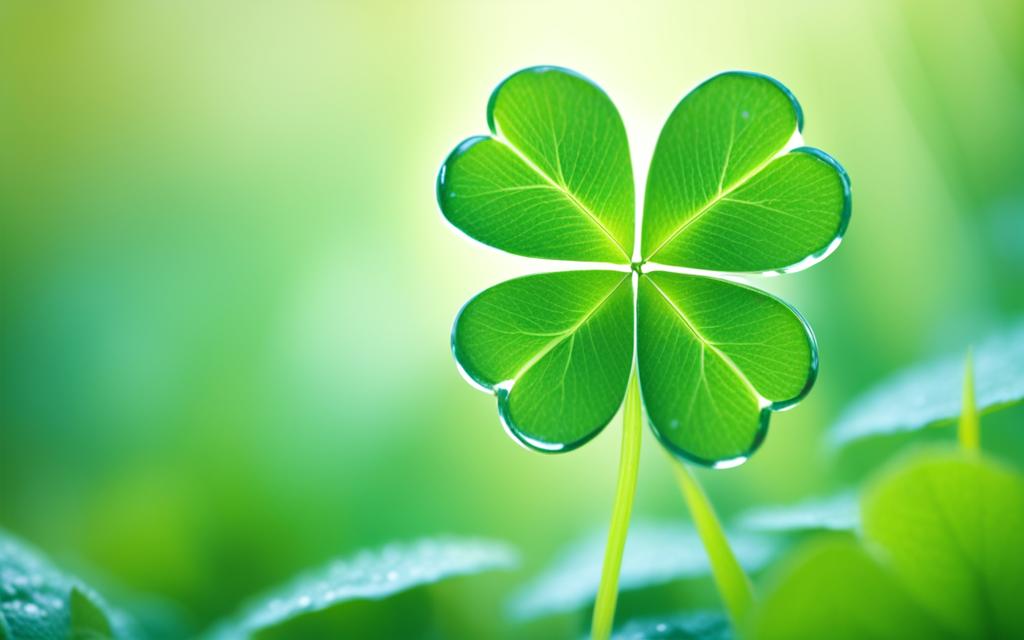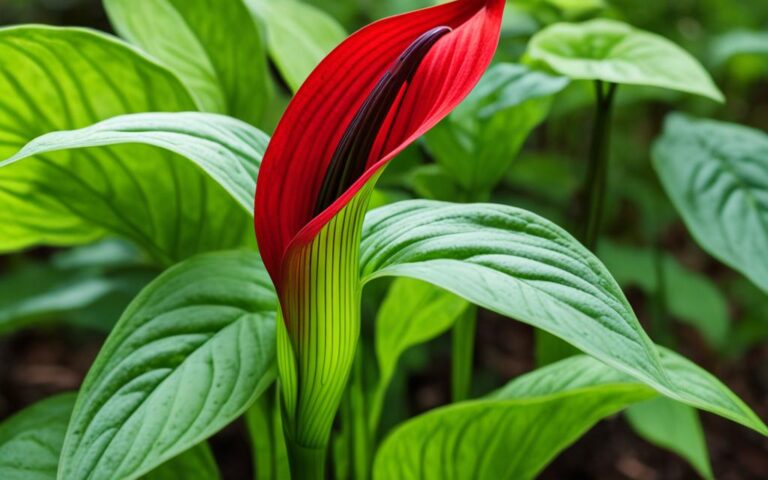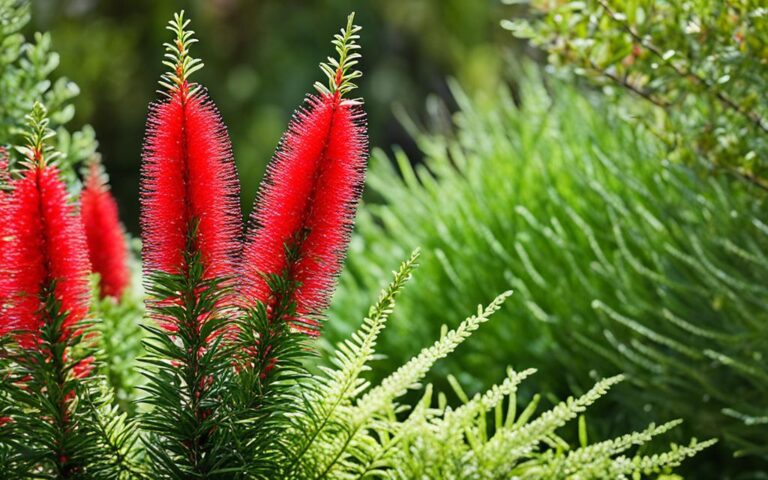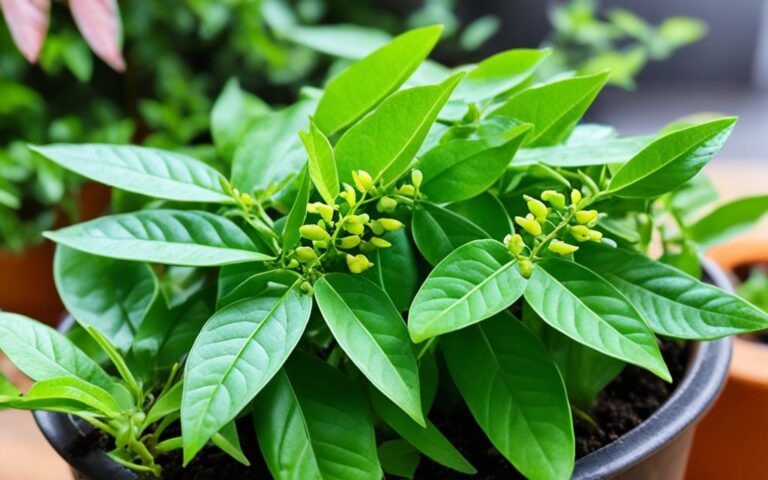Four Leaf Clover Plant: Nature’s Lucky Charm
Finding a four-leaf clover is very rare, happening only about 1 in 5,000 times. This makes them special and sought after by many. People all over the world see them as a sign of good luck and fortune. Let’s explore why this plant is so fascinating and what makes it so lucky.
Key Takeaways
- The four-leaf clover is a rare variant of the common three-leaf clover, with an extra leaf due to a genetic mutation.
- Finding a four-leaf clover is an uncommon occurrence, with odds estimated around 1 in 5,000.
- The four-leaf clover has long been revered as a symbol of good luck, with roots in ancient Celtic and Christian traditions.
- Cultivating a positive mindset and belief in luck can have a beneficial impact on well-being and goal-setting.
- Collecting and preserving four-leaf clovers is a popular hobby, with some individuals amassing impressive personal collections.
The Allure of the Four Leaf Clover Plant
The four-leaf clover is rare and seen as a symbol of luck, hope, faith, love, and fortune. It has fascinated people for centuries, with each leaf standing for a different value. In Irish culture, it’s linked to St. Patrick, who used the shamrock to explain the Holy Trinity.
Rarity and Cultural Symbolism
Only about one four-leaf clover is found in every 5,000 common three-leaf clovers. This makes it very rare. People have long seen it as a plant with special powers. Ancient Celts thought it could spot demons because of its cross-like shape.
Folklore and Mythology
The four-leaf clover is also famous in stories and myths worldwide. In Irish tales, it was said to be picked at night under the full moon by witches. It was thought to give the power to see fairies.
In the 19th century, a young girl wrote about fairies telling her that finding a four-leaf clover brought luck. This shows how the clover has always been linked to magic.
The four-leaf clover is important in many cultures, especially on St. Patrick’s Day. Its rarity makes it a symbol of unique chances in life. People often share stories of good luck after finding one.
Unveiling the Secrets of the Four Leaf Clover
Botanical Characteristics and Genetics
The four-leaf clover is a rare version of the common three-leaf clover, found in Trifolium repens or white clover. A genetic mutation leads to the fourth leaf, making these clovers much rarer than the usual three-leaf ones. Scientists have found the gene that changes a three-leaf clover into a four-leaf one.
White clover has many rare genes that affect its leaf colors and shapes. These include the red fleck mark and red midrib traits, each controlled by its own genes. This genetic variety helps the plant adapt and evolve. The work by the University of Georgia and the Samuel Roberts Noble Foundation has deepened our knowledge of white clover genetics. This knowledge is now helping in breeding new types of ornamental plants.
The Biology Behind the Fourth Leaf
Why some clovers have a fourth leaf is still a mystery with several theories. It could be due to a recessive gene, a random mutation, a mistake in development, or the effect of many genes. This means a single plant might have many four-leaf clovers, and those with unusual leaf numbers are more likely to produce more.
It’s believed that for every 10,000 clovers, one will have four leaves. However, in some places, the odds can be as high as 1 in 4,000. A young child once found four-leaf clovers by looking for their unique square shape. This shows how important persistence, time, and different strategies are for success.
“The research project received partial funding from the Samuel Roberts Noble Foundation and the Georgia Agricultural Experiment Stations, highlighting the ongoing efforts to decipher the genetics and evolution of white clover.”
Tracing the Historical Roots of the Four Leaf Clover
The four-leaf clover has deep roots in ancient Celtic societies. The Druids saw it as a powerful symbol of protection. They thought it helped them avoid evil spirits, linking it to luck and safety.
When Christianity spread through Europe, the clover’s meaning changed. It took on new symbols and traditions.
Ancient Celtic Beliefs and Druidic Traditions
The Druids, spiritual leaders of the Celts, valued the four-leaf clover highly. They saw it as a plant with magical powers, keeping away evil. Its four leaves stood for earth, air, fire, and water, showing balance in nature.
Transition to Christian Symbolism
With Christianity’s rise in Europe, the clover’s meaning changed. St. Patrick, Ireland’s patron saint, used the three-leaf shamrock to explain the Holy Trinity. The three-leaf clover linked to St. Patrick’s Day, but the four-leaf clover kept its luck and protection symbolism.
“The four-leaf clover is a rare variant of the common three-leaf clover, and its discovery has long been considered a sign of good fortune and luck.”
The shift from Celtic to Christian beliefs shows the four-leaf clover’s lasting charm. It remains a symbol of luck and protection for many.
four leaf clover plant: A Global Icon of Luck
The four-leaf clover has been a symbol of good luck and protection for centuries. It appears in art, literature, and popular culture. It has kept its importance as a global icon of luck through the ages.
Presence in Art, Literature, and Pop Culture
Artists, writers, and creatives have always been inspired by the four-leaf clover. It’s found its way into classic tales like “Hamlet” and “The Importance of Being Earnest.” Today, it’s in the logos of companies like Alfa Romeo and SpaceX, and in movies and ads.
Role in Celebrations and Holidays
St. Patrick’s Day is closely tied to the four-leaf clover, celebrating Irish culture. But it’s also a symbol of luck and fortune worldwide. The four-leaf clover is celebrated in many holidays, making it a global symbol of hope and positivity.
| Probability of Finding | Odds |
|---|---|
| 4-leaf clover in Europe | 1 in 5,000 |
| 5-leaf clover | 1 in 24,400 |
| 6-leaf clover | 1 in 312,500 |
The four-leaf clover has become a symbol in art, literature, and pop culture. It’s linked to Irish heritage and seen as a symbol of luck worldwide. It holds a special place in people’s hearts and minds.
The Science of Finding Four Leaf Clovers
Looking for the rare four-leaf clover has been a long-standing interest for many. These clovers are not just symbols of luck. They show the interesting science behind their growth. To find these clovers, knowing the best conditions and how to search is key.
Identifying Ideal Growing Conditions
Four-leaf clovers grow best in lush areas like parks, gardens, meadows, or well-kept lawns. These places are perfect for the rare four-leaf clovers to grow among the common three-leaf ones. Research shows that only 1 in 5,000 clover plants will have a fourth leaf, making them very rare.
Systematic Search Techniques
To find a four-leaf clover, use a methodical search. Focus on small areas of clover patches and scan them in rows or patterns. Look during the early morning or late afternoon when the sun isn’t too strong. The unique shape of the four-leaf clover makes it easier to spot.
Studies show that warm summer weather can lead to more four-leafed clover plants. This means you might find more during the summer.
| Factors Influencing Four-Leaf Clover Formation | Findings |
|---|---|
| Genetic Markers | Research has found genetic markers linked to the four-leaf trait in white clover. However, these traits might not always appear due to environmental factors. |
| Temperature and Daylight | Warmer summers and the right amount of daylight can greatly increase four-leafed clover numbers. |
| Chromosome Structure | White clover has four complete copies of its genome, which affects the growth of three and four-leafed clovers. |
By learning about the science of four-leaf clovers and searching systematically, you can boost your chances of finding one. This could bring you the luck it’s believed to offer.
Cultivating Your Own Luck
Want to find four-leaf clovers? Growing your own clover patch at home is a great idea. Some clover seeds are more likely to produce four-leaf clovers. By growing your own, you can watch the clovers grow and learn about their patterns and variations.
Growing Clover Patches at Home
To start, pick a spot that gets plenty of sunlight and has good drainage. Clear the area of weeds and debris. Then, follow the seed package for how to plant the clover seeds. Make sure they’re spread out evenly.
Keep the soil moist until the seeds sprout. After that, water regularly to keep it healthy.
Enhancing the Chances of Finding Four Leaf Clovers
There are ways to boost your chances of finding a four-leaf clover. Search after it rains, when the leaves are fresh and bright. Also, look in areas with lots of clover, as four-leaf clovers often grow near the common three-leaf ones.
By growing your own clover patch, you can up your odds of finding a four-leaf clover. It’s a fun and rewarding way to connect with nature.
“The real luck comes from labor, and the kind of luck that lasts comes from work.”
– Harry Golden, American writer and publisher
The Enduring Appeal of the Four Leaf Clover
The four-leaf clover has a deep symbolic meaning that has lasted for a long time. Each leaf is thought to stand for hope, faith, love, and luck. This makes the clover more than just a plant; it’s a symbol of good values and dreams.
Symbolism of Hope, Faith, Love, and Luck
The symbolism of four leaf clovers is based on the idea that each leaf means something different. The first leaf is for hope, the second for faith, the third for love, and the fourth for luck. This has made the four-leaf clover very popular around the world as a sign of good luck and positive things to come.
The meaning of four leaf clovers goes beyond luck. It includes many hopes and values that people from different cultures and beliefs share. The clover’s ability to represent these common human wishes has made it a lasting symbol of hope, faith, love, and success.
“The four-leaf clover is a rare and precious find, a symbol of good luck and fortune that captivates the imagination and inspires hope in the hearts of those who seek it.”
Only one out of about 5,000 clovers is a four-leaf clover, making it very rare. This rarity, along with its deep symbolic meaning, has made the four-leaf clover a cherished symbol of luck and positivity.
Preservation and Display of Four Leaf Clovers
For those who love four-leaf clovers, collecting and keeping them is a special hobby. These rare plants are often saved as precious items. People use different ways to keep them safe, like pressing, laminating, making crafts, and jewelry.
Pressing and Laminating Techniques
Pressing four-leaf clovers between book pages is a common way to save them. It usually takes a week for the clover to dry, but it might take longer in humid places. Some people also use a mix of glycerol and water or bronze the clover for a special look.
Laminating pressed clovers helps protect them well. This means putting the clover in a laminator to seal it in a clear cover. After, you can trim the extra laminate for a clean look.
Incorporating into Crafts and Jewelry
Four-leaf clovers can also be used in crafts and jewelry. They can be made into paperweights, framed, or even turned into jewelry. Some people put dried clovers in polyester or stick them to acid-free paper with safe glue.
Whether it’s pressed, laminated, or turned into jewelry, keeping four-leaf clovers lets us enjoy their luck and meaning. They symbolize luck, hope, and positivity.
The Psychology of Luck and Positivity
Believing in luck, like the four-leaf clover, can really help our minds. People who think they’re lucky often feel happier and do better in life. This belief makes us look at life with hope and optimism, which helps in many ways.
Belief in Luck and Its Impact on Well-being
Seeing luck as stable and in our control makes us more driven to reach our goals. Positive thinking also helps with money goals and makes us happier overall. By using the four-leaf clover symbol and cultivating a positive mindset, we can enjoy the psychological benefits of believing in luck.
Cultivating a Positive Mindset
Positive thinking does more than just make us feel good. It actually changes how we live and feel. By believing in the power of luck and good fortune, we get more motivated, set better goals, and feel more in control.
“The more you praise and celebrate your life, the more there is in life to celebrate.” – Oprah Winfrey
Using the four-leaf clover symbol every day can remind us to stay positive and think about luck and optimism. This leads to a more rewarding and psychologically beneficial life.
Four Leaf Clover Lore Around the World
The four-leaf clover is more than just a symbol in Ireland and Europe. It has a deep meaning in many cultures around the world. People see it as a rare and special plant with many different beliefs and stories.
Cultural Variations and Interpretations
In ancient Druidic traditions, the four-leaf clover was believed to help see spirits. In Japan, people respect clovers with more leaves than usual. This shows how the four-leaf clover has become important in many cultures. Even though finding one is rare, happening only 1 in 10,000 times, it still fascinates people everywhere.
Over time, the four-leaf clover has come to mean faith, hope, love, and luck. During “The Troubles” in Ireland, the shamrock became a symbol of Irish-Catholic Nationalism, showing its deep connection to culture and beliefs.
Clover is special in many cultures for its ability to fix nitrogen and act as a natural fertilizer. It’s also great for lawns because it needs less water, can survive droughts, and stands up to foot traffic well. This makes it a popular choice for eco-friendly gardens today.
From the Druids to the Japanese, the four-leaf clover has always caught people’s imaginations. It shows how nature’s small wonders can inspire beliefs, traditions, and bring people together worldwide.
Eco-friendly Practices for Clover Hunting
Looking for the rare four-leaf clover? It’s key to do it in an eco-friendly way. By being sustainable, we lessen our impact on nature. Teaching kids about caring for the environment helps them love nature and hunt for clovers responsibly.
Respecting Nature and Minimizing Impact
When hunting for four-leaf clovers, be gentle with their homes. Don’t step on the plants or disturb other creatures. Make sure you leave the area as you found it.
Sustainable Gardening Techniques
Want to grow your own clovers? Use eco-friendly gardening methods. Choose organic fertilizers and save water. This helps clovers and other plants thrive together in a healthy garden.
“The true sign of intelligence is not knowledge but imagination.” – Albert Einstein
By being eco-friendly in our clover hunts, we help protect their homes. With care and respect, we can keep the joy of finding four-leaf clovers alive for the future.
Engaging Children with Four Leaf Clover Traditions
Introducing kids to four-leaf clovers can connect them with nature and spark wonder. It’s a great way to teach them about the world around us. With fun activities and crafts, kids can learn about the cultural and historical importance of these plants.
Nature Activities and Crafts
Guided nature walks to find four-leaf clovers are exciting adventures. Activities for children involving four leaf clovers include scavenger hunts. Kids can look for as many of these rare plants as they can. After finding them, they can press and preserve the clovers as a keepsake.
Four leaf clover crafts for kids are also fun and creative. Kids can make keychains, jewelry, and decorate picture frames with these lucky charms. These projects let kids bring the magic of four-leaf clovers into their daily lives.
Teaching Environmental Stewardship
Searching for four-leaf clovers is not just fun; it teaches kids about taking care of the environment. By showing them how to respect the clover’s natural habitats, we teach them to protect nature. Teaching environmental stewardship through four leaf clover activities helps kids appreciate and care for the world around them.
These activities make kids interested in four-leaf clovers and their meaning. They also learn to protect the ecosystems that support these plants. This way, kids develop a lifelong love for nature and a sense of responsibility.
Conclusion
The four-leaf clover has amazed people all over the world for centuries. It started with Celtic and Christian stories and now symbolizes luck, faith, hope, and love. This plant has become a big part of our culture.
When we learn about its history, the secrets of nature, and its importance worldwide, we value nature’s surprises more. The four-leaf clover inspires us, makes us think positively, and links us to nature.
It’s rare, found in only about 1 in 10,000 clovers, making finding it magical and lucky. By knowing the best places to grow it and how to search, we can find these special plants. This brings us joy.
Let’s keep the spirit of the four-leaf clover alive. It stands for faith, hope, love, and luck. By taking care of our surroundings, teaching kids about nature, and staying positive, we can keep the four-leaf clover’s message alive for future generations. This plant will always amaze us, showing us the magic in small things.






